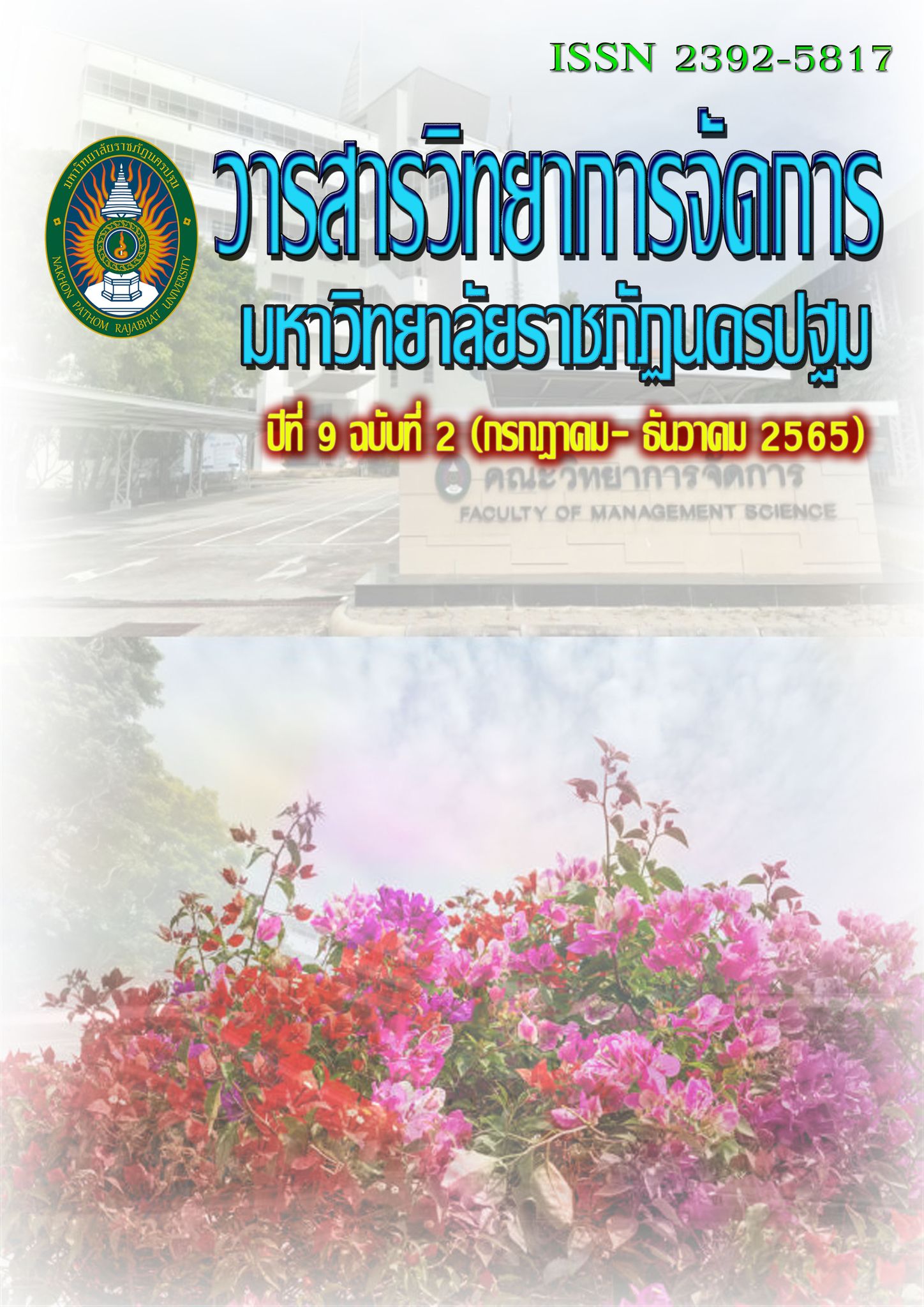Work Adaptation and Work Performance during COVID-19: A Case Study of Employees at a Private Bank in Bangkok
Main Article Content
Abstract
The situation as a result of the COVID-19 outbreak has had a significant impact on financial sectors. Due to this ongoing disruption, employees in financial institutions need to adapt their work processes to enhance their job performance. This research aimed to compare work performance during COVID-19 classified by personal factors and to study work adaptation affecting work performance during COVID-19 with focus on employees at a private bank in Bangkok as a case study. This study used a questionnaire as the primary research instrument. Data was collected from 262 samples out of 520 populations by using the stratified random sampling technique. For the statistics that used to analyze descriptive data were frequency, percentage, mean and standard deviation, and inference statistics were t-test, one-way ANOVA, and multiple linear regression. The results showed that: 1) employees who differ in gender, education level, and work experience have statistically significant differences between groups; 2) work adaptation could explain 89.5 % (R2 = .895) of work performance during COVID-19. The regression equation was
ŷ = .030 + .034x1 + .450x2** + .341x3** + .181x4**
Article history: Received 2 March 2022
Revised 2 May 2022
Accepted 5 May 2022
SIMILARITY INDEX = 6.97 %
Article Details

This work is licensed under a Creative Commons Attribution-NonCommercial-NoDerivatives 4.0 International License.
The views and opinions of the article appearing in this journal are those of the author. It is not considered a view and responsibility of the editorial staff.
References
กนกวรา พวงประยงค์. (2564). สถานการณ์ผลกระทบ ความต้องการการช่วยเหลือ และการปรับตัวของคนวัยทำงานในช่วงการแพร่ระบาดของโควิด-19: การศึกษาเชิงประจักษ์ในกรุงเทพมหานคร. วารสารสุทธิปริทัศน์, 35(1), 266-286.
ดาวรุ่งรตา วงษ์ไกร. (2563). การบริหารจัดการองค์การที่มีผลต่อคุณภาพชีวิตการทำงานตามมาตรการเฝ้าระวังป้องกันและควบคุมการแพร่ระบาดโรคไวรัสโคโรนา 2019 (COVID-19) ของบุคลากร สำนักงานหลักประกันสุขภาพสาขาเขตพื้นที่ 13 กรุงเทพมหานคร. วารสารวิทยาการจัดการ มหาวิทยาลัยราชภัฏนครปฐม, 7(2), กรกฎาคม – ธันวาคม, 257-269.
เทคซอส. (2564). NIA ชี้เทรนด์ใหม่ Work from Home มีแนวโน้มขยายตัวพร้อมเร่งมาตรการกระตุ้น Startup และ SMEs. [ออนไลน์]. ค้นเมื่อ 15 เมษายน 2564, จาก https://techsauce.co/pr-news/nia-work-from-home-covid-19#.
ประเวศน์ มหารัตน์สกุล. (2544). การบริหารจัดการทรัพยากรมนุษย์ด้วยเทคโนโลยีสารสนเทศ.
(พิมพ์ครั้งที่ 2). กรุงเทพฯ : สมาคมส่งเสริมเทคโนโลยี.
ปาริฉัตร โชติภูมิเวทย์. (2564). การบริหารจัดการกระบวนการทำงานที่บ้าน (WFH) เพื่อคุณภาพชีวิตของพนักงานต่อประสิทธิภาพการทำงานในภาวะวิกฤตโควิด-19 ของกลุ่มธนาคาร. การค้นคว้าอิสระ การจัดการมหาบัณฑิต มหาวิทยาลัยมหิดล.
พรรัตน์ แสดงหาญ. (2563). การปรับตัวในการทำงานที่บ้านของผู้ปฏิบัติงานในเขตพัฒนาพิเศษภาคตะวันออกในช่วงวิกฤตโควิด-19. วารสารการจัดการธุรกิจมหาวิทยาลัยบูรพา, 9(2), 14-33.
วรุตม์ อยู่ยอด. (2564). การรับมือกับการเปลี่ยนแปลงและการปรับตัวในการทำงานของพนักงานธนาคารภายใต้สถานการณ์โควิด-19. สารนิพนธ์การจัดการมหาบัณฑิต มหาวิทยาลัยมหิดล.
สรวุฒิ เอี่ยมนุ้ย. (2564). ปัจจัยที่มีผลต่อการปฏิบัติงานตามบทบาทอาสาสมัครสาธารณสุขประจำหมู่บ้านในการเฝ้าระวังและป้องกันโรคโควิด-19 อำเภอกงไกรลาส จังหวัดสุโขทัย. วารสาร สาธารณสุขและสุขภาพศึกษา, 1(2), 75-90.
อัญชลี กตัญญู และพงศกร เขมวัฒน์เดชา. (2564). ศักยภาพการปรับตัวเพื่อรองรับสถานการณ์โรคติดเชื้อไวรัสสายพันธุ์ใหม่ 2019 (COVID-19) ในกลุ่มอุตสาหกรรมผลิตเครื่องจักรกลในประเทศไทย. วารสารบริหารธุรกิจอุตสาหกรรม, 3(1), 35-58.
อภิชล ทองมั่ง กำเนิดว้ำ และสุรสิทธิ์ ระวังวงศ์ (2563). การทำงานที่บ้าน: แนวทางการจัดการเพื่อเพิ่มประสิทธิภาพและเทคโนโลยีที่เกี่ยวข้อง. วารสารครุศาสตร์อุตสาหกรรม, 19(3), 119-130.
Roy, Sr. C., & Andrews, H. (1999). The Roy adaptation model (2nd ed.). Stamford: Appleton & Lange.
Yamane, T. (1973). Statistics: An introductory statistic, (3rd Edition). New York: Harper & Row.

